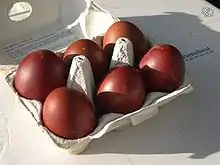Marans
The Marans, French: Poule de Marans, is a breed of chicken from the port town of Marans, in the département of Charente-Maritime, in the Nouvelle-Aquitaine region of south-western France. It was created with the local feral chickens descended from fighting game chickens carried from Indonesia and India. Those original Marandaise fowl were "improved" for the table through recombination with imported Croad Langshans. A favourite at poultry shows, it is a dual-purpose fowl known both for its extremely dark eggs and fine meat qualities.
 A cuckoo Marans hen | |
| Other names |
|
|---|---|
| Country of origin | France |
| Standard | Marans-Club de France (in French) |
| Traits | |
| Weight | |
| Egg colour | dark brown |
| Comb type | single |
| Classification | |
| APA | Continental[2] |
| EE | yes[3] |
| PCGB | soft feather: heavy[4] |
| |
History
The Marans originated in Marans, France, and were imported into the United Kingdom in the 1930s.
Characteristics
Ten colours are recognised in the French breed standard for large fowl: white, wheaten, silver cuckoo, golden cuckoo, black, copper-black, silver-black, copper-blue, black-tailed buff and Columbian.[1] Bantam colours are black, white, copper-black and silver cuckoo.[1] Fourteen colours are listed by the Entente Européenne.[3] In the United Kingdom only five are recognised – black, copper-black, dark cuckoo, golden cuckoo and silver cuckoo.[5]:195[6]:172
They should have orange eyes. The shanks are usually slate or pink, the soles of the feet should always be white as Marans have white skin, not yellow. Though the original Marans could also be feather-legged birds, British breeders preferred the clean-legged version, and thus feather-legged Marans are now mainly found in France and the United States. The Australian Poultry Standard recognises both feather- and clean-legged.[7] The American Poultry Association only recognises feather-legged.
Use

Marans hens lay around 150–200 dark brown eggs each year depending on the variety. Marans are historically a dual-purpose bird, prized not only for their dark eggs but for their table qualities as well.
References
| Wikimedia Commons has media related to Marans. |
- Standard officiel de la Marans (in French). Marans-Club de France. Archived 4 March 2016.
- APA Recognized Breeds and Varieties: As of January 1, 2012. American Poultry Association. Archived 4 November 2017.
- Liste des races et variétés homologuée dans les pays EE (28.04.2013). Entente Européenne d’Aviculture et de Cuniculture. Archived 16 June 2013.
- Breed Classification. Poultry Club of Great Britain. Archived 12 June 2018.
- J. Ian H. Allonby, Philippe B. Wilson (editors) (2018). British Poultry Standards: complete specifications and judging points of all standardized breeds and varieties of poultry as compiled by the specialist breed clubs and recognised by the Poultry Club of Great Britain, seventh edition. Chichester; Hoboken, New Jersey: Wiley Blackwell. ISBN 9781119509141.
- Victoria Roberts (2008). British Poultry Standards: complete specifications and judging points of all standardized breeds and varieties of poultry as compiled by the specialist breed clubs and recognised by the Poultry Club of Great Britain, sixth edition. Oxford: Blackwell. ISBN 9781405156424.
- 2nd Australian Poultry Standard, 2012, published by the Victorian Poultry Breeder Association (trading as Poultry Stud Breeders and Exhibitors Victoria)
